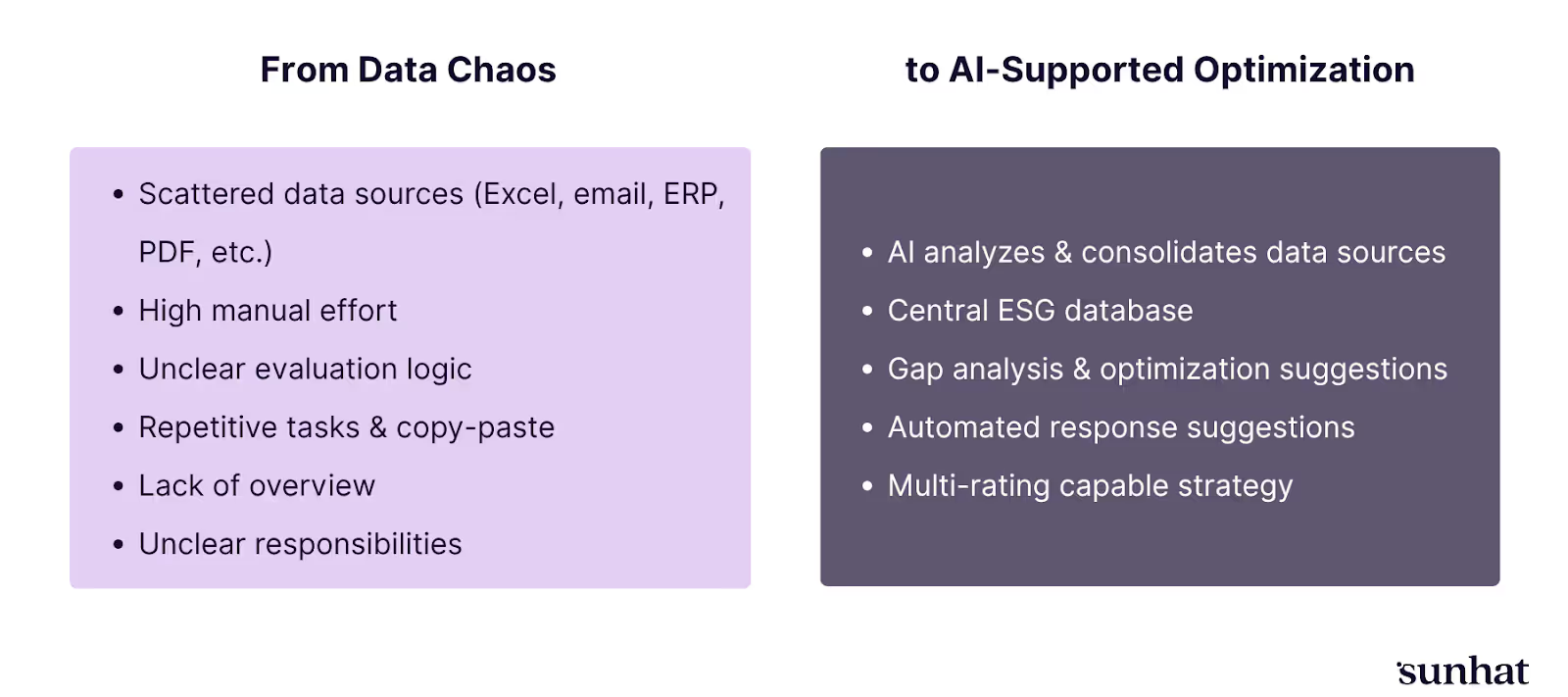Latest update July 9, 2025
[cg_add-class=heading-style-h4]In a Nutshell
- ESG ratings entail complex requirements and a high time expenditure
- Many processes are still manual and fragmented, leading to data chaos, inconsistencies, and inefficient processing
- AI technologies automate the consolidation of data, identify gaps in content and help to prepare precise and standardized responses
- Smart automation enables sustainability teams to save time, create strategic added value and sustainably improve the quality of their ESG ratings
ESG ratings are no longer a sideshow: they influence value creation, access to capital and a company's own competitiveness.
Whether CDP, EcoVadis or MSCI: the rating logics are becoming more complex, the requirements more granular, the timing tighter. For those responsible for sustainability, this means increasing effort and rising expectations – both internally and externally. Nevertheless, many processes are still manual, fragmented and inefficient.
This is precisely where the leverage lies: artificial intelligence can substantially accelerate ESG rating processes, consolidate data and prepare answers consistently. Not as a technical end in itself, but as a strategic tool in everyday ESG. Those who rely on intelligent automation now gain time, an overview, and a real head start.
ESG Ratings: Often More Work Than Impact
Many sustainability teams struggle with the same issues when it comes to answering ESG questionnaires:
- Data chaos: Information is scattered in Excel files, ERP systems, emails or with external partners.
- Time expenditure: Preparing for the CDP questionnaire alone can take several months every year.
- Unclear evaluation logic: Every rating agency weights things differently. What counts at EcoVadis plays a smaller role at CDP and vice versa.
- Repetition instead of improvement: Instead of showing real progress, often only the last report is updated.
The result: a lot of effort for each individual, but little strategic added value and sustainable impact.
How AI takes ESG Ratings to the Next Level
1. Multi-rating optimization instead of lone wolf approach
AI simultaneously analyzes the evaluation criteria of CDP, EcoVadis, MSCI, Sustainalytics and ISS ESG. It recognizes overlaps, differences and optimizes the data strategy for all ratings in parallel with a central data collection, intelligent assignment of measures and automatic adaptation of communication to the requirements of the respective rating agencies.
2. Intelligent gap analysis for better scores
AI analyzes documents and data sources in comparison with the requirements of common ESG ratings such as EcoVadis or CDP. It identifies gaps, provides targeted improvement tips and shows where content is incomplete, unspecific, or not rating-compliant. The well-founded evaluation with regard to impact and relevance and prioritization of measures is then carried out by experts.
3. Smart data consolidation instead of data chaos
AI-supported tools extract relevant information from a wide variety of sources – such as ERP systems, supplier portals, PDFs or Excel files and bundle it in a standardized, structured form. This creates a consistent data basis for ESG ratings.
4. Understanding content instead of just searching through it
Whether it's a code of conduct, company policy or audit report – AI automatically reads complex documents and recognizes ESG-relevant content. The structured classification saves time and creates transparency regarding existing information.
5. Suggested answers for rating questions: quick start with intelligent assistants
Based on existing data, AI generates initial well-founded answer suggestions for common ESG questionnaires – for example for CDP or other rating systems. This makes answering more efficient and standardized.
AI not only saves time, but also brings structure to an often chaotic process and creates space for what really matters: impact.

CEOs Rely on AI
According to the latest Gartner study, 77% of CEOs see AI as the most important driver in their industry over the next three years. It is seen as a key technology, particularly in risk management, process automation and the development of new capacities.
For sustainability teams, too, this means that those who start integrating AI in a meaningful way today not only create operational relief, but also strengthen their own strategic role in the company.
Conclusion: Now is the Right Time for AI
AI is no substitute for sustainability work. But it can help to solve repetitive tasks more efficiently, improve the database and approach ESG ratings with greater clarity.
The effort remains, but it becomes manageable. And those who specifically use smart tools, such as Sunhat, benefit twice over: from less stress and better scores.
Stop scrambling. Start proving.
Your next customer questionnaire, assessment, or audit doesn't have to be a fire drill. Get the platform that keeps proof ready for every request.

Sustainability managers benefit particularly from AI for ESG ratings such as CDP, EcoVadis and MSCI because these ESG ratings are based on complex, different assessment logics. AI can help to meet the requirements in parallel by pooling data centrally, recognizing overlaps and making individual adjustments automatically.
It is not necessary to completely rebuild the entire ESG system in order to benefit from AI. AI can be gradually integrated into existing processes, for example for automatic data capture, gap analysis in documents or automated classification of content.
The use of AI actually saves time because repetitive and manual tasks such as collecting, consolidating and analyzing data are automated. This relieves the burden on sustainability teams and frees up valuable time for strategic work instead of routine tasks.


.avif)



.avif)


%201.svg)






